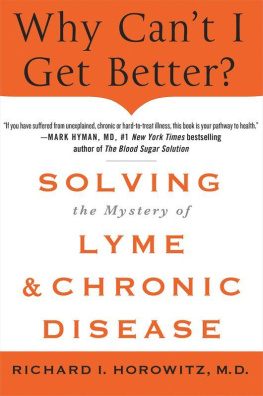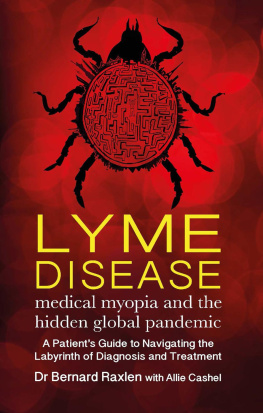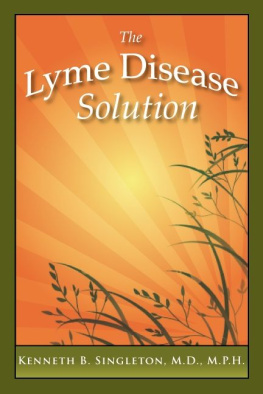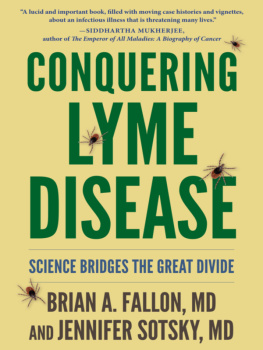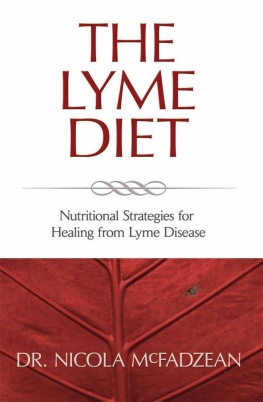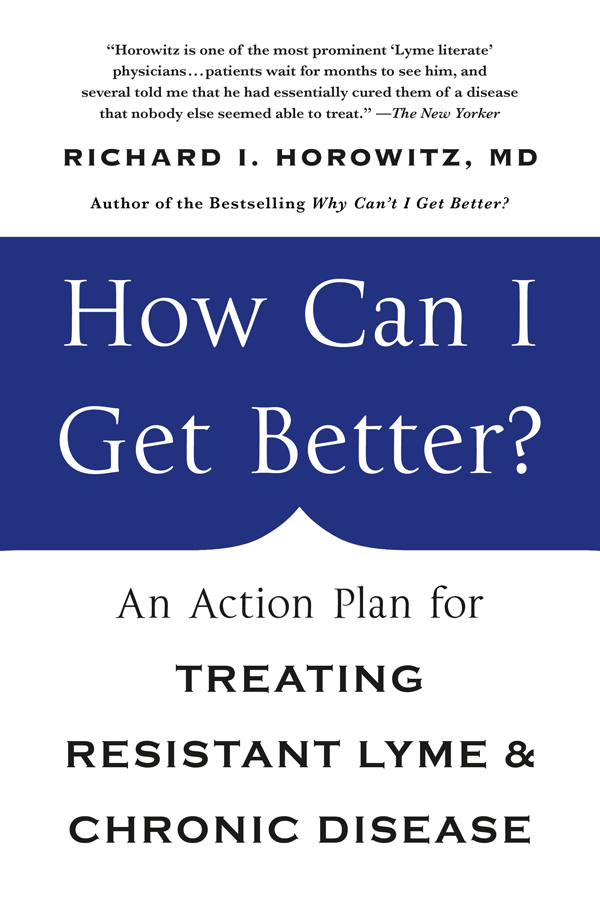Contents
Guide

The author and publisher have provided this e-book to you for your personal use only. You may not make this e-book publicly available in any way. Copyright infringement is against the law. If you believe the copy of this e-book you are reading infringes on the authors copyright, please notify the publisher at: us.macmillanusa.com/piracy.
To my wife, Lee, and the millions of people suffering from Lyme and associated tick-borne disorders
This book couldnt have been written without the help of many people. Jennifer Weis at St. Martins Press has been an invaluable supporter for many years, and Im thrilled that I was able to work with her. Pam Liflander has been helpful in getting my thoughts onto these pages clearly and coherently.
A huge thanks goes out to my wife, Lee, for her understanding and support, as long hours (including on vacation) were needed to get this book into its present form. Her love has graced my life.
My office staff also deserves a special thank-you for their dedication, hard work, skill, knowledge, and compassion, which has allowed me to help so many stricken with chronic illness. These people include John Fallon, FNP-C (Batman); Janet M. Cosh, AAS; Lisa Haynes; Danielle Passineau; Angela Jacobs; Diamond Elting; Renee Nelson; Kalah Matthews, BSN; Sonja Siderias, AAS, LPN; Etheldria Walker, MA; and Barbara Semanick, BSN, RN. A special thanks and large debt of gratitude goes to Phyllis R. Freeman, PhD, senior researcher at our center, whose skill, compassion, and hard work has allowed us to publish new groundbreaking research on Lyme and co-infections.
I would also like to acknowledge Dr. Mark Hyman and the speakers from the Institute for Functional Medicine (IFM) conference in San Diego, California, as well as Dr. Leo Galland and Dr. Chris Melitis, from the Integrative Health Symposium conference in New York City, who contributed material. Dr. Eva Sapi, from the University of New Haven, shared her original research on biofilms. A debt of gratitude also goes out to Dr. Alan McDonald for his groundbreaking work on Borrelia and permission to reprint his slides on its cystic form and biofilms, as well as Dr. Judith Miklossy, who provided photos of the atypical and cystic forms of Borrelia in neurological Lyme disease. Dr. Claire Riendeau provided her insight on biotoxin illness. I also wish to thank Dr. Garth Nicolson for reviewing the initial manuscript and for his assistance in providing extensive scientific literature on mycoplasmal infections and mitochondrial dysfunction. I would also like to recognize the heroes of Lyme disease, who have consistently put their patients before themselves, sometimes at the risk of their own careers. This includes Dr. Joseph Burrascano (who also provided a short history of Lyme disease for this book, and information on Advanced Labs and the new Lyme culture); Dr. Sam Donta; Dr. Charles Ray Jones; Dr. Kenneth Leigner; and many others.
I am also grateful for the assistance of several colleagues who lent their expertise and reviewed individual chapters: Allan Warshowsky, MD, for his work on the endocrinology chapter; David H. Haase, MD, for reviewing the GI autonomic nervous system dysfunction and allergy chapters; Andrea Gaito, MD, for her help with the immunity and inflammation chapters; Sunil Khurana, MD, for helping with the GI and liver function chapters; Fred Harvey, MD, for his assistance in reviewing the chapter on environmental medicine; and David Perlmutter, MD, FACN, who reviewed the brain and pain chapters. Dr. Elizabeth Maloney and Dr. Bea Szantyr also provided their feedback on the manuscript, and I am grateful for their help.
A huge debt of gratitude goes to my spiritual teachers, who have guided and supported me perfectly through this life.
Finally, thanks to all of the Lyme-MSIDS sufferers, who have been some of the greatest teachers to me in this lifetime. Your courage and perseverance to regain health has inspired me to constantly look for answers, and has been the inspiration for this book.
Lyme and associated tick-borne diseases are rapidly spreading worldwide, mimicking a host of common illnesses such as chronic fatigue syndrome (CFS, now renamed as systemic exertional intolerance diseaseSEID), fibromyalgia (FM), and autoimmune diseases like rheumatoid arthritis (RA), lupus, and multiple sclerosis (MS). These tick-borne diseases can even imitate psychiatric conditions such as depression, anxiety, obsessive-compulsive disorder (OCD), and psychosis. Lyme is known as the great imitator, and I have witnessed tremendous suffering among the twelve-thousand-plus patients I have treated during the past twenty-nine years.
Lyme disease may also be one of the driving forces underlying multiple chronic diseases. People from all over the United States and abroad come to my office complaining of chronic fatigue and varying pain syndromes, as well as cognitive and neuropsychiatric problems. These symptoms often are severe and can result in long-term disability. Many of my patients have the same story. They have gone from doctor to doctor looking for answers and only ended up getting help once their Lyme, associated co-infections, and multiple overlapping medical illnesses were all simultaneously addressed.
In 2013 I published my first book, Why Cant I Get Better? Solving the Mystery of Lyme and Chronic Disease . It has been tremendously satisfying that this book is often referred to as the Lyme Bible and that it has changed the way doctors both understand and treat this debilitating disease. This new book is an updated and simpler version, and it includes some of the most important scientific discoveries to emerge since the original publication. For instance, we now know that there are bacterial persistersbacteria that can survive short courses of antibioticsand how pulsing medication, treating biofilms that protect bacteria, and using established persister drugs for other chronic bacterial diseases may lead to better outcomes. I have done studies in my office on these newer protocols, taking the research from the laboratory into the clinical setting, and I am seeing successful outcomes in patients who have failed prior therapies. This is very exciting, as our team at the Hudson Valley Healing Arts Center has searched for close to thirty years to find answers for people who are suffering with persistent/resistant symptoms. Details of these new and effective protocols are in this book to help you get better.
LYME IS SPREADING
While you may know of the health epidemics of obesity, diabetes, cardiovascular disease, strokes, heart attack, and cancer, unless you or a family member has faced Lyme disease, you might not know that we are also witnessing epidemics of bacterial, viral, and parasitic illnesses. Lyme disease is the number one vector borne spreading infectious disease in the United States and in Europe (while rapidly expanding to other countries like Canada, Australia, and China).
Several months after my first book was published, the Centers for Disease Control and Prevention (CDC) reported that 1.3 percent of respondents of a survey in the United States in 2009, and 0.9 percent in 2012, had been diagnosed with Lyme disease. Of the respondents in 2012, 0.3 percent had been diagnosed in the last year. This forced the CDC to revise their figures and increase the rate of annual infection by a factor of ten, from thirty thousand to over three hundred thousand individuals a year. These numbers have more recently been revised and found to be even higher. A 2015 CDC study, published in the journal Emerging Infectious Diseases , discussed the geographic distribution and expansion of Lyme disease in the United States over the past twenty years. They found a 320 percent increase in the northeastern states, and in the north-central states where the number of counties having a high incidence of Lyme disease increased by greater than 250 percent for the same period. According to the CDC, The center of the high-incidence focus in the northeastern United States generally moved westward and northward, away from the coast of northern New Jersey and into east-central Pennsylvania. In the north-central high-incidence focus, the geographic center remained relatively stable in northwestern Wisconsin, moving northward and southward between adjacent counties over time. Their conclusion was that relatively constant rates of geographic expansion (were happening) in all accessible directions.


